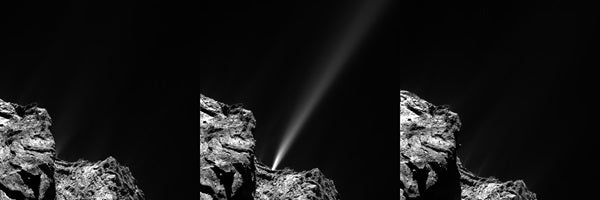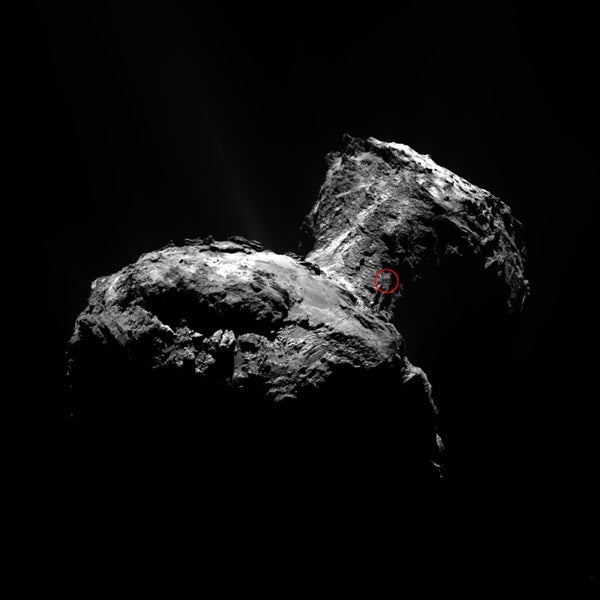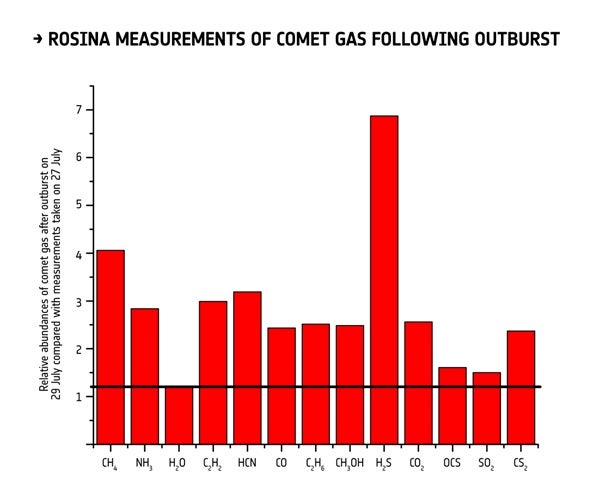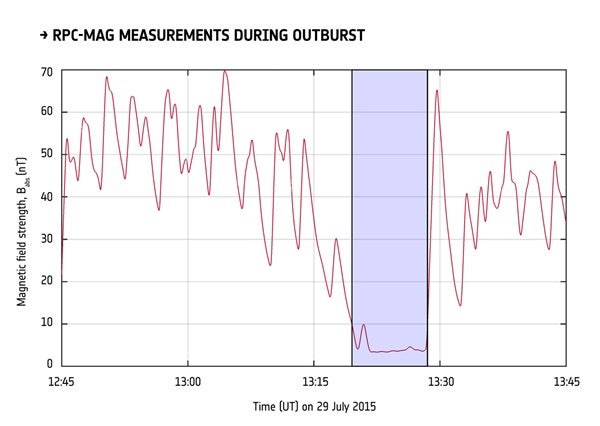The comet reaches perihelion August 13, the moment in its 6.5-year orbit when it is closest to the Sun. In recent months, the increasing solar energy has been warming the comet’s frozen ices, turning them to gas, which pours out into space, dragging dust along with it.
The period around perihelion is scientifically very important as the intensity of the sunlight increases and parts of the comet previously cast in years of darkness are flooded with sunlight.
Although the comet’s general activity is expected to peak in the weeks following perihelion, much as the hottest days of summer usually come after the longest days, sudden and unpredictable outbursts can occur at any time — as already seen earlier in the mission.
Perhaps most surprisingly, Rosetta found that the outburst had pushed away the solar wind magnetic field from around the nucleus.
A sequence of images taken by Rosetta’s scientific camera OSIRIS show the sudden onset of a well-defined jet-like feature emerging from the side of the comet’s neck, in the Anuket region. It was first seen in an image taken at 13:24 GMT, but not in an image taken 18 minutes earlier, and has faded significantly in an image captured 18 minutes later. The camera team estimates the material in the jet to be traveling at 33 feet per second (10 m/s) at least, and perhaps much faster.
“This is the brightest jet we’ve seen so far,” commented Carsten Güttler, OSIRIS team member at the Max Planck Institute for Solar System Research in Göttingen, Germany. “Usually, the jets are quite faint compared to the nucleus and we need to stretch the contrast of the images to make them visible — but this one is brighter than the nucleus.”
Soon afterward, the comet pressure sensor of ROSINA detected clear indications of changes in the structure of the coma, while its mass spectrometer recorded changes in the composition of outpouring gases.
The graph shows the relative abundances of various gases after the outburst, compared with the measurements two days earlier.
“This first ‘quick look’ at our measurements after the outburst is fascinating,” said Kathrin Altwegg, ROSINA principal investigator at the University of Bern. “We also see hints of heavy organic material after the outburst that might be related to the ejected dust.
“But while it is tempting to think that we are detecting material that may have been freed from beneath the comet’s surface, it is too early to say for certain that this is the case.”
Meanwhile, about 14 hours after the outburst, GIADA was detecting dust hits at rates of 30 per day, compared with just 1–3 per day earlier in July. A peak of 70 hits was recorded in a four-hour period August 1, indicating that the outburst continued to have a significant effect on the dust environment for the following few days.
“It was not only the abundance of the particles, but also their speeds measured by GIADA that told us something ‘different’ was happening: The average particle speed increased from 8 m/s [26 ft/s] to about 20 m/s [65 ft/s], with peaks at 30 m/s [100 ft/s] — it was quite a dust party!” said Alessandra Rotundi, principal investigator at the ‘Parthenope’ University of Naples, Italy.
The solar wind is the constant stream of electrically charged particles that flows out from the Sun, carrying its magnetic field out into the solar system. Earlier measurements made by Rosetta and the Philae lander had already shown that the comet is not magnetized, so the only source for the magnetic field measured around it is the solar wind.
But it doesn’t flow past unimpeded. Because the comet is spewing out gas, the incoming solar wind is slowed to a standstill where it encounters that gas and a pressure balance is reached.
“The solar wind magnetic field starts to pile up, like a traffic jam, and eventually stops moving towards the comet nucleus, creating a magnetic field-free region on the Sun-facing side of the comet called a ‘diamagnetic cavity,’” explained Charlotte Götz, magnetometer team member at the Institute for Geophysics and extraterrestrial Physics in Braunschweig, Germany.
Diamagnetic cavities provide fundamental information on how a comet interacts with the solar wind, but the only previous detection of one associated with a comet was made at about 2,500 miles (4,000km) from Comet Halley as ESA’s Giotto flew past in 1986.
Rosetta’s comet is much less active than Halley, so scientists expected to find a much smaller cavity around it, up to a few tens of kilometers at most, and prior to July 29 had not observed any sign of one.
But following the outburst on that day, the magnetometer detected a diamagnetic cavity extending out at least 116 miles (186km) from the nucleus. This was likely created by the outburst of gas, which increased the neutral gas flux in the comet’s coma, forcing the solar wind to “stop” farther away from the comet and thus pushing the cavity boundary outward beyond where Rosetta was flying at the time.
“Finding a magnetic field-free region anyway in the solar system is really hard, but here we’ve had it served to us on a silver platter — this is a really exciting result for us,” added Götz.
“We’ve been moving Rosetta out to distances of up to 300 kilometers [200 miles] in recent weeks to avoid problems with navigation caused by dust, and we had considered that the diamagnetic cavity was out of our grasp for the time being. But it seems that the comet has helped us by bringing the cavity to Rosetta,” said Matt Taylor, Rosetta project scientist. “This is a fantastic multi-instrument event which will take time to analyze but highlights the exciting times we’re experiencing at the comet in this ‘hot’ perihelion phase.”













